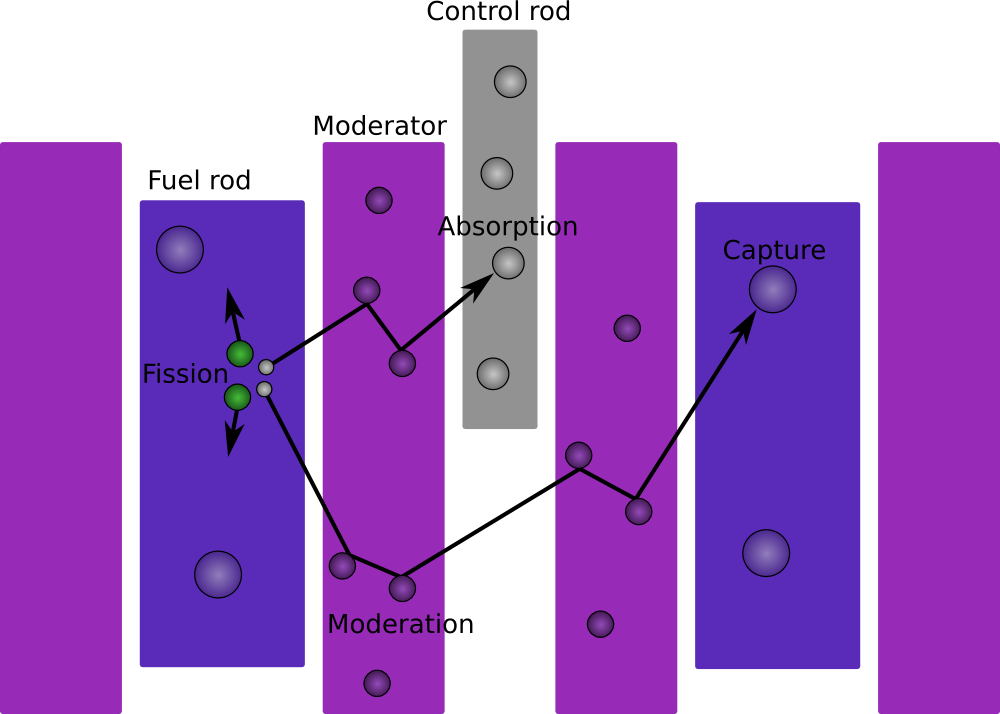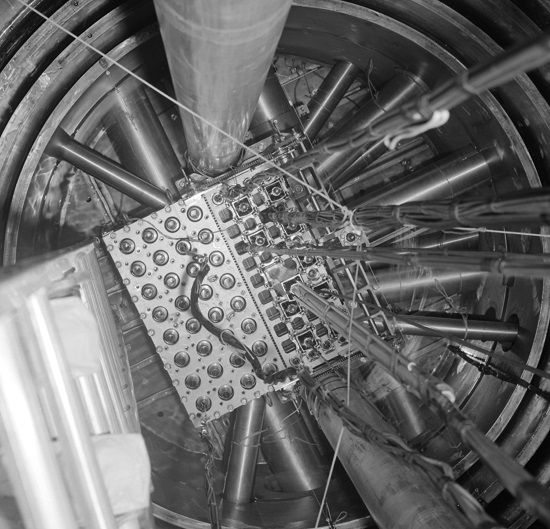Dr. Zoomie – how do they start up and shut down nuclear reactors, and how do they keep from going out of control? Is it all automatic systems and computers?
Control rods!
I guess I could leave it at that, but where’s the fun in that? Here’s how the control rods work, how they’re used, and how they’re controlled. But first, a little background information.
Nuclear reactors run on neutrons. It’s neutrons that cause fissions and unless enough neutrons can find an atom to fission the reaction will fizzle out. If we can control the neutrons then we can control the reactor. The question is how to control the neutrons.
It turns out that every different type of atom – not just every element, but every isotope – has a different ability to absorb neutrons. Physicists call this a “cross-section” and they recognize cross-sections for neutron capture, fission, and other reactions. The term cross-section isn’t strictly accurate – an atom with a high neutron capture cross-section isn’t physically larger than one with a small cross-section – but it helps to understand how the atoms are behaving. A neutron that’s aimed at an atom with a high neutron capture cross section is more likely to be captured than one aimed at an atom with a low cross-section, just as a ball thrown at a large door is more likely to pass through (to be “absorbed” by the room beyond) than one thrown at a small window. And that’s a path to starting up, shutting down, and controlling a nuclear reactor – find a way to control the number of neutrons flying around the reactor core by using rods that can absorb neutrons before they can cause a fission.
So picture a reactor core – a grid of fuel rods immersed in water. There’s always a low level of fission taking place, some due to cosmic rays, some due to the spontaneous fission of U-238 in the fuel, and some due to the spontaneous fission of transuranic elements created when any reactor is operating. Each spontaneous fission produces a few neutrons and it’s these that we’re going to decide what to do with.
Neutrons caused by fission start off with high velocities and they’re unlikely to cause fission; to put it in nuclear engineering terms, most isotopes have a low cross-section for fast fission. Slowing the neutrons down – moderating them – increases their fission cross-section, and water is a great moderator. So when a fission takes place the neutrons leave the fuel rod and pass through the cooling water, slowing down as they do so; when they enter the neighboring fuel rod they’re at a good velocity to be absorbed by a uranium atom and to cause a fission.
This is where control rods come into plan – if we put control rods between the fuel bundles then they’ll intercept and absorb the neutrons before they have a chance to cause a fission. Pulling control rods out of the core exposes more fuel to neutrons and lets reactor power increase; pushing the rods into the core drives power down.

The last piece of the puzzle is that reactors operate on a fine balance of neutrons – on average, for each fission that occurs, one of the two or three neutrons produced must cause another fission. It’s not necessary to absorb every neutron produced by every fission that takes place; it’s only necessary to absorb enough of them that the reactor power starts to drop, finding a new equilibrium at a lower power.
This is sort of like driving a car – if you’re cruising down the highway at a steady speed then your engine is putting out just enough energy to overcome friction and wind resistance; if you ease up on the gas pedal even just a little the you interrupt this balance; the car slows down until the lower power level is enough to overcome the lower levels of wind resistance and friction at the lower speed. If you take your foot off the gas completely then the car will eventually slow to a stop. Similarly, shimming control rods in, even just a little, will absorb enough neutrons to cause reactor power to drop slightly until it reaches a new equilibrium; shimming them out a tad will cause power levels to increase. If you’ve got an emergency and need to shut down the reactor in a hurry, simply push all of the rods into the core and it will shut down – in this case we’re not only taking our foot off the gas, but stomping on the brake as well.
Let’s think about our reactor core again, nicely shut down with all control rods fully inserted into the core. To start it up all we need to do is to start pulling the rods out of the core. As I mentioned earlier, there’s always a low level of fissions happening in the core, producing a low level of neutrons; as we pull rods more of these neutrons are absorbed by U-235 (the uranium isotope that fissions best) atoms, causing the number of fissions to increase. This, in turn, causes the neutron flux to increase, causing still more fissions, and resulting in more neutrons being absorbed by the control rods. Power continues to increase until a new equilibrium is reached and neutron flux levels off…and then starts to drop again because the control rods are still absorbing too many neutrons to allow the chain reaction to maintain itself. Bump the rods out again and the process repeats itself. Eventually enough fuel is exposed to the unattenuated neutron flux that the reactor is able to maintain a constant number of fissions – at that point the reactor is “critical.” From here, pulling rods increases reactor power, inserting them reduces it.
To push the automobile analogy a tad more, think of starting a car with a manual transmission – as you ease the clutch out it starts to engage, but at first it’s not enough to push the car forwards – the clutch plates are still slipping past each other. And then you get to the point where the clutch is engaged enough to overcome the weight of the car – that’s when the car starts to move forward (the equivalent of the reactor reaching criticality). From this point, the gas pedal takes the place of the control rods and it’s the position of the gas pedal that controls how quickly you’re moving down the highway.
There are other factors involved in reactor controls – we can inject materials into the coolant to absorb neutrons, we can add automatic controls that are similar to cruise control, The most common automatic control is a reactor scram; inserting some or all control rods into the core to quickly shut the reactor down.
So that’s how reactors are controlled – by controlling the neutrons using rods with a high neutron absorption cross-section. Easy-peasy!
